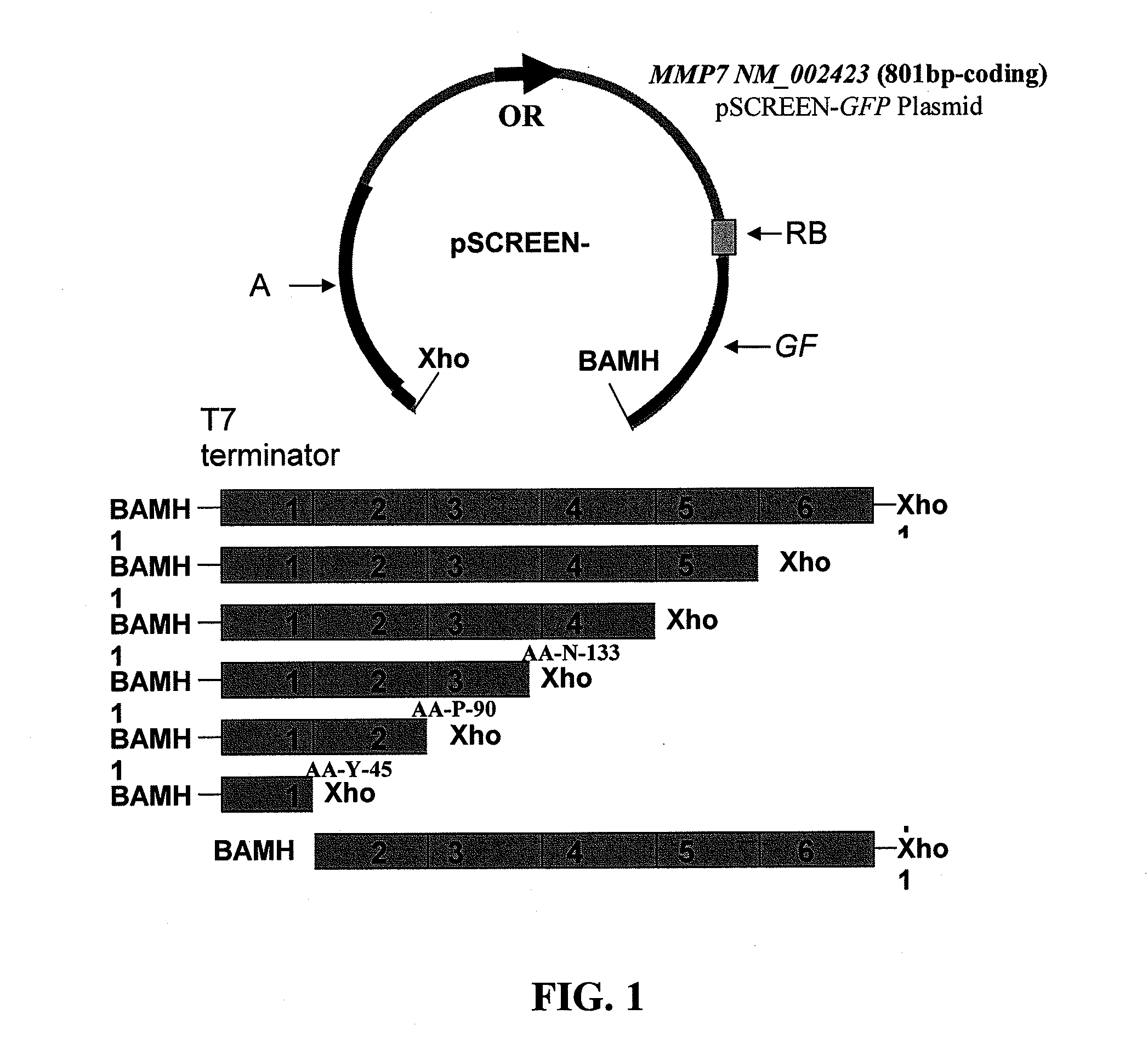Matrix metalloproteinase-7 (mmp-7) monoclonal antibodies and methods for their use in the detection of ovarian cancer
a technology of metalloproteinase and monoclonal antibodies, which is applied in the field of matrix metalloproteinase7 (mmp7) monoclonal antibodies and methods for the detection of ovarian cancer, can solve the problems of no recognition, increased risk of ovarian cancer, and stepwise progression of ovarian cancer through defined precursor lesions, so as to improve the clinical outcome of many patients and increase survival
- Summary
- Abstract
- Description
- Claims
- Application Information
AI Technical Summary
Benefits of technology
Problems solved by technology
Method used
Image
Examples
example 1
Production of Mouse Monoclonal Antibodies to MMP-7
[0072]Recombinant antigen immunization strategies were undertaken to generate mouse monoclonal antibodies specific for MMP-7. The immunogenic polypeptide used to produce the mouse MMP-7 monoclonal antibodies comprised the MMP-7 sequence (SEQ ID NO:1) fused to a small polypeptide linker and a carboxy-terminal hexahistidine tag. The sequence of the MMP-7 immunogenic polypeptide is set forth in SEQ ID NO:5. The immunogenic MMP-7 polypeptide was overexpressed in a HEK (human embryonic kidney) cell line that contains the nucleic acid encoding the Epstein-Barr Nuclear Antigen, and the hexahistidine-tagged MMP-7 protein was purified from the media fraction using a chelating agarose charged with Ni+2 ions (Ni-NTA, Qiagen Inc.).
[0073]Mice were then immunized with the purified MMP-7 protein and lymphocyte fusions were accomplished by performing Repetitive Immunizations Multiple Sites technology (RIMMS), essentially as described in Kilpatrick e...
example 2
General Method for Epitope Mapping
General Approach
[0075]Epitope mapping was performed essentially as described in U.S. Patent Application Publication No. 2006 / 0252106 to identify the linear or non-linear, discontiguous amino acid sequence within an antigenic protein (i.e., the epitope in, for example, MMP-7) that is recognized by a particular monoclonal antibody. A general approach for epitope mapping requires the expression of the full-length protein, as well as various fragments (i.e., truncated forms) of the protein, generally in a heterologous expression system. These various recombinant proteins are then used to determine if the specific monoclonal antibody is capable of binding one or more of the truncated forms of the target protein. Through the use of reiterative truncation and the generation of recombinant proteins with overlapping amino acid regions, it is possible to identify the region that is recognized by the monoclonal antibody under investigation. Western blot analys...
example 3
Sandwich ELISA Assay Utilizing MMP-7 Monoclonal Antibodies 5G11.9 and 15H8.12 to Detect MMP-7 in Ovarian Cancer in Patient Serum Samples
[0078]The sandwich ELISA immunoassay was used to detect MMP-7 in sera from ovarian cancer patents and ovarian cancer-free patients. The capture antibody used in this set of experiments, the 5G11.9 MMP-7 antibody, was bound to a microtiter plate well by passive absorption, as is known in the art. The 15H8.12 antibody was used as the detector antibody and was labeled with horseradish peroxidase (HRP; the detectable substance) for detection of antigen-antibody binding using the chromagen tetramethylbenzidine (TMB). The “readout” for antigen-antibody binding was optical density (OD) at 450 nM and was measured using standard methods in the art. The patient sera samples were analyzed using the sandwich ELISA technique, essentially as described above, to measure MMP-7 levels in sera from a patient cohort of 91 ovarian cancer patients, at various stages of ...
PUM
| Property | Measurement | Unit |
|---|---|---|
| pH | aaaaa | aaaaa |
| size | aaaaa | aaaaa |
| cure rate | aaaaa | aaaaa |
Abstract
Description
Claims
Application Information
 Login to View More
Login to View More - R&D
- Intellectual Property
- Life Sciences
- Materials
- Tech Scout
- Unparalleled Data Quality
- Higher Quality Content
- 60% Fewer Hallucinations
Browse by: Latest US Patents, China's latest patents, Technical Efficacy Thesaurus, Application Domain, Technology Topic, Popular Technical Reports.
© 2025 PatSnap. All rights reserved.Legal|Privacy policy|Modern Slavery Act Transparency Statement|Sitemap|About US| Contact US: help@patsnap.com


